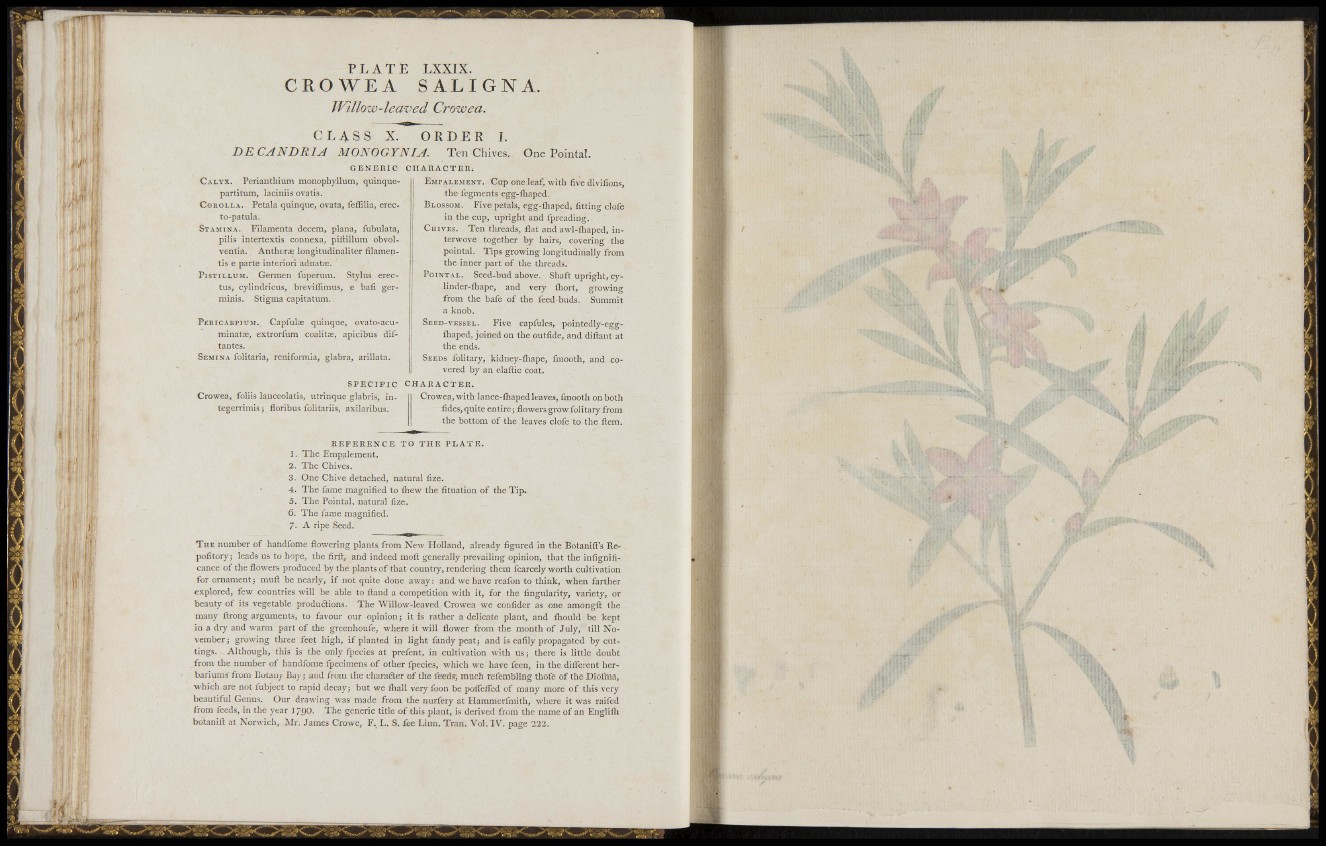
P L A T E LXXIX.
CROWE A SALIGNA.
Wlllow-leazìed Crowea.
C L A S S X. ORDER I.
DE CAN DRIA MONOGYNIA. Ten Chives.
GENERIC CHARACTER.
CALYX. Perianthium monopbyllum, quinquepartitum,
laciniis ovatis.
CQKOLLA. Pétala quinqué, ovata, iéiììlia, erecto
patula.
STAMINA. Filamenta decern, plana, fubulata,
pilis intertextis connexa, piltillum obvolventia.
Antherae longitudinaliter filamentis
e parte interiori adnatae.
P I S T I L L U M . Germen luperum. Stylus erectas,
cylindricus, brevilìiraus, e bali germinis.
Stigma capitatum.
One Pointai.
PEiiiCAKriüM. Capfulíe quinqué, ovato-acuminatEe,
extrorfum coalitas, apicibus diltantes.
SEMINA Iblitaria, reniformia, glabra, arillata.
S P E C I F I C
Crowea, foUis lanceolatis, utrinque glabris, integerrirais;
floribus folitariis, axilaribus.
EMPALEMENT. Cup one leaf, with five divifions,
the legments egg-fliaped.
BLOSSOM. Five petals, egg-iliaped, fitting dole
in the cup, upright and Ipreading.
CHIVES. Ten threads, flat and awl-lliaped, interwove
together by hairs, covering the
pointal. Tips growing longitudinally from
the inner part of the threads.
P O I N T A L . Seed-bud above. Shaft upright, cylinder
fliape, and very iliort, growing
from the bale of the feed-buds. Summit
a knob.
SEED-VESSEL. Five capfules, pointedly-eggfliaped,
joined on the outfide, and diftant at
the ends.
SEEDS folitary, kidney-fliape, fraooth, and covered
by an elaftic coat.
CHARACTER.
Crowea, with lance-fhaped leaves, fmooth on both
fides, quite entire; flowers grow folitary from
the bottom of the leaves clofe to the Hem.
REFERENCE TO THE PLATE.
1. The Empalement.
2. The Chives.
3. One Chive detached, natural fize.
4. The fame magnified to fhew the iituation of the Tip.
5. The Pointal, natural fize.
6. The fame magnified.
7. A ripe Seed.
THE number of handfome flowering plants from New Holland, already figured in the Botanift's Repofitory;
leads us to hope, the firft, and indeed moft generally prevailing opinion, that the infignificance
of the flowers produced by the plants of that country, rendering them fcarcely worth cultivation
for ornament; mnft be nearly, if not quite done away: and we have reafon to think, when farther
explored, few countries will be able to ftand a competition with it, for the fingularity, variety, or
beauty of its vegetable produdions. The Willow-leaved Crowea we confider as one amongft the
many ftrong arguments, to favour our opinion; it is rather a delicate plant, and Ihould be kept
in a dry and warm part of the greenhoufe, where it will flower from the month of July, till November;
growing three feet high, if planted in light fandy peat; and is eafily propagated by cuttings.
Although, this is the only fpecies at prefent, in cultivation with us; there is little doubt
from the number of handfome fpecimens of other fpecies, which we have feen, in the diflerent herbariums
from Botany Bay; and from the charaaer of tlie feeds, much refembling thofe of the Diofma,
which are not fubject to rapid decay; but we fliall very foon be poifeffed of many more of this very
beautiful Genus. Our drawing was made from the nurfery at Hammerfmith, where it was raifed
from feeds, in the year 1790. The generic title of this plant, is derived from the name of an Englilli
botanifl at iVorwich, Mr. James Crowe, F. L. S. fee Linn. Tran. Vol. IV. page 223.